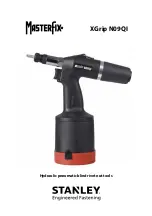
For advice on the safety and suitability of this
equipment contact your local HSS Hire.
Keep children, animals and bystanders away from the
work area.
Never use this equipment if you are ill, feeling tired, or
under the influence of alcohol or drugs.
This equipment should only be used by a competent
person who has read and understood these
instructions.
Ensure the work area is well lit and ventilated. Do not
work near flammable gases or liquids.
Safety Goggles MUST be worn by everyone in the
work area.
NOTE: Some materials being broken by this
process may contain substances which can be
harmful to health. A suitable mask must be worn when
using this equipment.
NOTE: This equipment generates potentially
harmful noise levels. To comply with health and
safety at work regulations, ear defenders must be
worn by everyone in the vicinity.
Wear practical, protective clothing and
footwear. Avoid loose garments and
jewellery that could catch in moving parts.
Check the equipment before use. If it shows signs of
damage or excessive wear, return it.
If working above ground-level, work from a suitable,
stable platform – an access tower for example. Never
work from ladders or steps.
Take special care when breaking anything containing
pipework or electrical cables. If in doubt, hire a cable
avoiding tool from your local HSS Hire, to determine the
exact position of such hazards.
Stop the machine if you experience discomfort or
numbness during use.
Information on COSHH regulations is available from
your local HSS Hire.
Most HSS air tools require a 125 cfm compressor to run
them. The air connections used are the claw type quick
action couplings.
If the tool fails, or if its hose or coupling gets damaged,
return it. Never try to repair it yourself.
Keep the air hose/s out of harm’s way, keep it clear of
moving parts. Never run them through water, over
sharp edges or where they could trip someone.
Never carry or pull the equipment by its air hose.
Never allow compressed air to travel down an air hose
A
AIIR
R S
SA
AF
FE
ET
TY
Y
G
GE
EN
NE
ER
RA
AL
L S
SA
AF
FE
ET
TY
Y
which is not connected to an air tool or securely
anchored, this may cause personal injury.
Ensure the air supply is turned OFF before connecting
or disconnecting it from the air hose. Isolate it from the
air supply before making any adjustments.
Make sure you know how to switch the equipment OFF
before you switch it ON.
With the compressor warmed up, and the air supply
valve CLOSED, connect the air hose to the compressor
by pushing it on to the air supply valve and turn
clockwise.
Anchor the delivery end of the air hose so that it is not
aimed at any person or property then, taking great
care, slightly open the air supply valve to clear the hose
of any debris. Now fully close the valve and turn the
compressor OFF.
Lay the breaker/pick down on a clean, firm surface, and
fit the appropriate steel for the work you are doing.
Make sure the steel’s shank is clean and in good
condition, then open the tool’s chuck by moving the
latch lever down. Insert the steel as far as it will go and
lock in place by moving the latch lever up.
Confirm that the tool’s control lever/trigger is in the
closed position, then connect the delivery hose in the
same way as to the compressor.
Fully open the compressor’s air supply valve and start
the compressor.
Always hold the tool with both hands then
bring the steel into contact with the surface to
be broken.
Adopt a stable posture with both feet on firm, level
ground, do not work in areas where you are
forced to stand on loose debris or on a slippery uneven
surface.
On first contact with the surface, the breaker/pick will
try to wander off line. Take great care until you become
familiar with the tool.
Depending on which tool you are using, either squeeze
the trigger or depress the control lever with the palm of
your hand.
Begin slowly, allowing the steel to mark the surface, this
will stop the steel from wandering over the work
surface and causing unnecessary and expensive
damage.
Never apply too much pressure, let the breaker/pick
work at its own pace.
Lift it clear before turning OFF, and wait for moving
parts to stop before putting it aside.
B
BA
AS
SIIC
C T
TE
EC
CH
HN
NIIQ
QU
UE
ES
S
G
GE
ET
TT
TIIN
NG
G S
ST
TA
AR
RT
TE
ED
D
Control
Lever
Chuck
Tarmac
Cutter
Point
Chisel
Compactor
Run
Latch
Lever
Open
Air Hose
Connection
B
Brre
ea
ak
ke
err




















